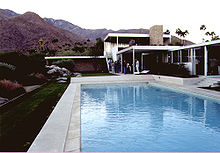Edgar J. Kaufmann
Edgar J. Kaufmann (also Edgar J. Kaufmann Sr.) (born November 1, 1885 in Pittsburgh ; † April 15, 1955 ) was an American entrepreneur and patron. As a successful owner of a department store in his hometown, he had sufficient financial means to have buildings built by well-known architects. Both his Fallingwater country estate in Pennsylvania, designed by Frank Lloyd Wright , and his home in Palm Springs, California designed by Richard Neutra , the Kaufmann Desert House , went down in architectural history as important buildings of the 20th century.
Life
Edgar J. Kaufmann was born in Pittsburgh to Morris Kaufmann and his wife Betty, née Wolf. He first attended Shady Side Academy in his hometown before enrolling as a student at Yale University . As part of his commercial training, he completed internships in various well-known department stores. These included the Marshall Fields department store in Chicago , the Galeries Lafayette in Paris and the Karstadt branch in Hamburg . In 1909 he married his cousin Lillian Kaufmann, the daughter of Isaac and Emma Kaufmann. A year later their son, who was also called Edgar J. Kaufmann, was born. In 1913, at the age of 28, he took over the management of the Kaufmann’s department store in Pittsburgh, which was founded in 1871 . The department store was founded by the brothers Jacob and Isaac Kaufmann, who immigrated from Germany. Edgar J. Kaufmann ran the department store until 1955. In addition, he was involved in a variety of social and cultural areas. For example, he financially supported the Pittsburghs Light Opera Company and donated $ 1.5 million to build the Civic Auditorium .
In 1934 Kaufmann met the architect Frank Lloyd Wright , whose students included Kaufmann's son. A close friendship developed between Edgar J. Kaufmann and Wright, which lasted until Kaufmann's death. Wright designed a new office for Kaufmann between 1935 and 1937, which was located within his Pittsburgh department store. The complete interior, including wood paneling and furniture, is now what is known as the Period Room in the Victoria and Albert Museum in London . At the same time, Wright was working on a weekend home for Kaufmann in the Allegheny Mountains . The property is located between the villages of Mill Run and Ohiopyle and the Bear Run stream flows through it. Kaufmann wanted a building with a view of a waterfall on the creek, but was convinced by Wright to include the waterfall in the building. The building, named after the Fallingwater waterfall , served the Kaufmann family as a weekend and holiday home until 1963, before the Kaufmann's son opened it to the public as a museum.
The native Austrian Richard Neutra , a former employee of Frank Lloyd Wright, designed another house built on behalf of Edgar J. Kaufmann. In 1946, the building known as the Kaufmann House or Kaufmann Desert House was built in Palm Springs, California, and served as a holiday home for the Kaufmann family. Through numerous glass walls, Neutra, like Wright at Fallingwater, included the surroundings in his plans. The building is one of Neutra's most famous works and is not open to the public.
literature
- Richard Louis Cleary: Merchant Prince and Master Builder , Carnegie Museum of Art, Pittsburgh 1999, ISBN 0-88039-036-0
Web links
- Biography of Edgar J. Kaufmann (English)
| personal data | |
|---|---|
| SURNAME | Kaufmann, Edgar J. |
| BRIEF DESCRIPTION | American entrepreneur and patron |
| DATE OF BIRTH | November 1, 1885 |
| PLACE OF BIRTH | Pittsburgh |
| DATE OF DEATH | April 15, 1955 |

